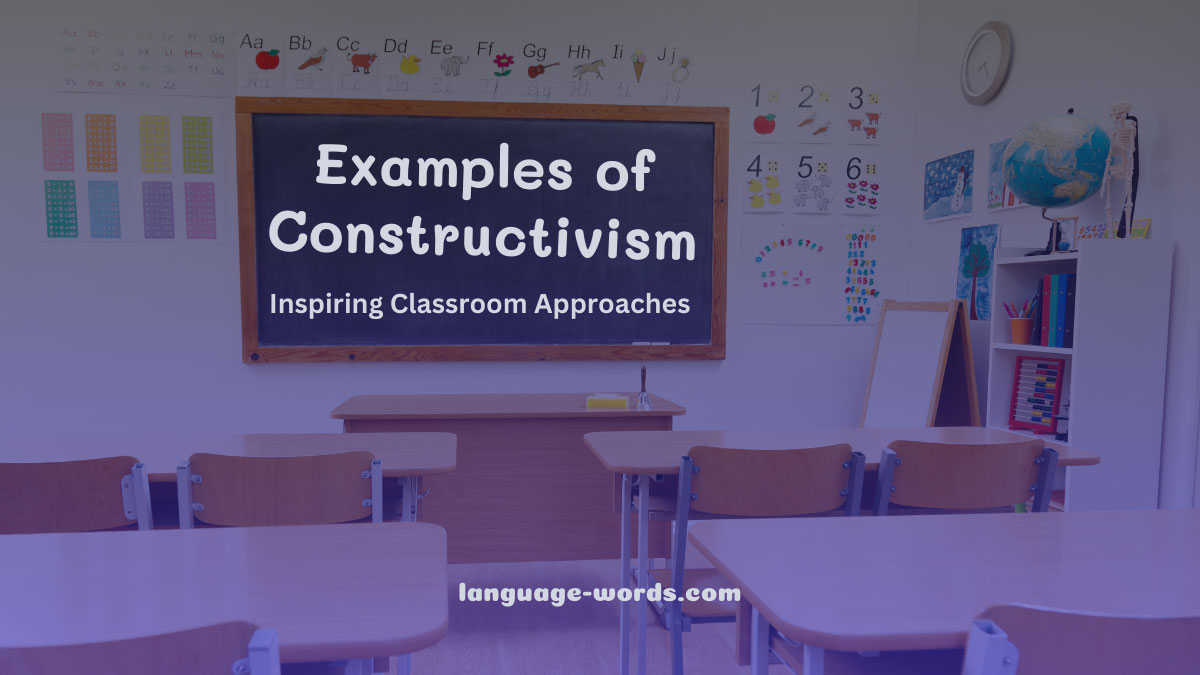Have you ever wondered how we construct knowledge and make sense of the world around us? Well, in this article, I’ll be diving into the fascinating world of constructivism and exploring some compelling examples that illustrate its principles. From the realms of education to psychology and even art, constructivism offers a unique perspective on how we learn, think, and create.
In the field of education, constructivism challenges traditional teaching methods by emphasizing active participation and hands-on learning. We’ll explore how educators use techniques like problem-based learning and collaborative projects to engage students and foster their critical thinking skills. Additionally, we’ll delve into the realm of psychology and examine how constructivism plays a role in understanding how individuals construct their own knowledge and meaning.
But constructivism isn’t limited to these fields alone. We’ll also take a look at how artists have embraced this theory to create thought-provoking artworks that challenge our perceptions and invite us to actively engage with the artistic process. So, whether you’re an educator, a psychologist, an artist, or simply curious about the ways in which we construct knowledge, join me on this journey as we explore captivating examples of constructivism and its impact on various aspects of our lives.
What is Constructivism?
Constructivism is a theory that emphasizes active learning and hands-on experiences as a means of constructing knowledge and understanding. It challenges traditional teaching methods by placing the learner at the center of the learning process. Instead of passively receiving information, learners actively engage with the material, build upon their existing knowledge, and construct their own understanding.
In the field of education, constructivism has had a profound impact on teaching practices. It encourages teachers to create a learning environment that fosters exploration, collaboration, and critical thinking. Instead of simply delivering information, educators facilitate opportunities for students to actively participate in their own learning. This can be done through experiments, group projects, problem-solving activities, and real-life applications of knowledge.

In psychology, constructivism plays a crucial role in understanding how individuals construct their own knowledge and meaning. According to constructivist theory, learning is an active process of constructing mental models based on personal experiences and interactions with the world. It highlights the importance of prior knowledge and personal beliefs in shaping an individual’s understanding of new information.
Outside the realm of education and psychology, constructivism has also found its place in the world of art. Artists have embraced constructivism as a way to challenge perceptions, provoke thought, and engage viewers in the artistic process. Constructivist artworks often combine various materials and techniques to create visually striking and conceptually complex pieces. They encourage viewers to actively interpret and construct their own meanings from the artwork.
Overall, constructivism is a powerful framework that emphasizes active learning, personal experiences, and hands-on engagement. It has transformed the way we approach education, psychology, and art, empowering individuals to take an active role in constructing their own knowledge and understanding.
Definition List For Examples of constructivism
Constructivism can be applied in various fields, from education to psychology and art. In this section, I’ll provide you with some real-world examples of constructivism in action. Let’s dive in!

Education:
- Project-Based Learning: This approach encourages students to actively engage in hands-on projects that require critical thinking, problem-solving, and collaboration. By taking an active role in their own learning, students construct their knowledge and understanding of the subject matter.
- Socratic Method: This teaching method involves asking thought-provoking questions to stimulate students’ thinking and challenge their existing beliefs. It promotes active participation and encourages students to construct meaning through dialogue and critical reflection.
Psychology:
- Cognitive Development: According to Jean Piaget’s theory of cognitive development, individuals actively construct knowledge through their interactions with the environment. They assimilate new information into their existing mental structures and adapt them through a process called accommodation.
- Social Constructivism: Lev Vygotsky’s theory of social constructivism emphasizes the role of social interactions and cultural context in learning. According to Vygotsky, individuals construct knowledge through collaborative activities with others, such as discussions and group projects.
Art:
- Installation Art: Installation artists create immersive, three-dimensional experiences that invite viewers to actively engage with the artwork. The meaning and interpretation of the artwork are constructed through the viewers’ interactions and personal experiences within the installation.
- Interactive Art: Interactive art installations use technology to allow viewers to actively participate and influence the artwork. By inviting viewers to become co-creators, interactive art blurs the boundaries between the artist and the audience, emphasizing the constructivist notion of active engagement.
These examples highlight the power of constructivism in shaping our understanding of the world around us. By encouraging active participation, personal experiences, and hands-on engagement, constructivism challenges traditional methods and fosters a deeper and more meaningful learning experience.
Remember, constructivism is not just a theory, but a practical approach that empowers individuals to construct their own knowledge and meaning. Embracing constructivist principles can lead to transformative educational experiences, insightful psychological perspectives, and thought-provoking artistic creations.
The Principles of Constructivism

Active Learning
In constructivism, active learning plays a central role. It emphasizes the importance of hands-on engagement and personal experiences in the learning process. Rather than passively receiving information, learners are actively involved in constructing their own knowledge and understanding.
Through active learning, students are encouraged to explore, experiment, and discover. This approach fosters critical thinking, problem-solving skills, and creativity. It also promotes a deeper understanding and retention of information. By actively participating in their learning, students become active agents in the construction of their own knowledge.
Inquiry-Based Learning
Another principle of constructivism is inquiry-based learning. This approach involves posing questions, exploring ideas, and seeking answers through independent investigation. By encouraging curiosity and a spirit of inquiry, learners develop a deeper understanding of the subject matter.
Inquiry-based learning promotes critical thinking, research skills, and the ability to analyze and evaluate information. It encourages students to ask meaningful questions, make connections, and draw conclusions based on evidence. Through inquiry, students become active participants in their own learning journey.
Examples of Constructivism in Action
Now that we have explored the principles of constructivism, let’s look at some examples of how it is applied in different fields.
The Role of the Teacher in Constructivism
In constructivist learning, the role of the teacher is crucial in facilitating meaningful experiences for students. As a teacher, I understand the importance of guiding students through the learning process and creating an environment that promotes active engagement and critical thinking.

Here are some key aspects of the teacher’s role in constructivism:
- Facilitator of Learning: Instead of being the sole purveyor of knowledge, I act as a facilitator, guiding students in their exploration of concepts and ideas. I encourage students to ask questions, investigate, and make connections, fostering a sense of ownership and autonomy in their learning journey.
- Creating a Supportive Environment: I establish a positive and supportive classroom environment where students feel safe to express their thoughts, take risks, and share their ideas. This creates a community of learners who collaborate and learn from each other’s experiences.
- Designing Authentic Tasks: I design tasks and learning experiences that are relevant and meaningful to students. By connecting learning to real-world situations and incorporating hands-on activities, I encourage students to apply their knowledge and skills in practical ways.
- Differentiating Instruction: Recognizing that each student has unique strengths and needs, I differentiate instruction to accommodate various learning styles and abilities. I provide a variety of resources, materials, and instructional methods to meet the diverse needs of my students.
- Promoting Reflection and Metacognition: I encourage students to reflect on their learning experiences and think about their thinking (metacognition). Through discussions, journals, and self-assessments, students develop a deeper understanding of their learning process and become more aware of their own thinking strategies.
By embracing the role of a facilitator, creating a supportive environment, designing authentic tasks, differentiating instruction, and promoting reflection and metacognition, I aim to foster a constructivist learning environment that promotes active engagement and empowers my students to become independent, critical thinkers. With constructivism, I believe I can inspire a lifelong love of learning in my students.
Examples of Constructivism in Practice

As a teacher who embraces constructivist principles, I believe in providing my students with hands-on, engaging learning experiences. In this section, I will share a few examples of how I incorporate constructivist approaches into my classroom.
Project-Based Learning
One effective way to promote constructivist learning is through project-based learning. I like to design projects that allow my students to delve deeply into a specific topic or theme. For example, if we are learning about animals, I might assign my students the task of creating a diorama of their favorite animal’s habitat. This project not only encourages creativity and critical thinking but also allows students to explore and apply their knowledge in a meaningful way.
Collaborative Learning
Collaborative learning is another powerful strategy that aligns well with constructivist principles. I believe in creating opportunities for my students to work together in small groups or pairs. This allows them to share ideas, learn from each other, and construct knowledge collectively. For instance, if we are studying a historical event, I might assign my students a group project where they research and present different aspects of the event. This not only fosters collaboration but also encourages deep understanding and analysis.
Socratic Seminars
Socratic seminars are an effective instructional strategy to engage my students in critical thinking and meaningful discussions. In a Socratic seminar, students take the lead in asking and answering open-ended questions about a text or topic. I facilitate the discussion by guiding their thinking and encouraging them to actively listen and respond to their peers. This approach promotes higher-level thinking skills, builds communication skills, and helps students construct their understanding through active dialogue.
Incorporating constructivist principles into my teaching practice has transformed the learning experiences of my students. Through project-based learning, collaborative activities, and Socratic seminars, I create an environment where students actively participate in constructing their own knowledge. By empowering them to explore, question, and reflect, I foster independent thinking and a love for learning.
Criticisms of Constructivism
One of the key aspects of constructivism is its focus on the active role of the learner in constructing their own knowledge. However, like any educational approach, constructivism has its fair share of criticisms. In this section, I’ll discuss some of the common criticisms of constructivism.
- Lack of Structure: One criticism leveled against constructivism is that it lacks a clear structure or framework for learning. Opponents argue that without a structured curriculum or set of objectives, students may struggle to grasp foundational knowledge and develop important skills. While constructivism values student autonomy and exploration, some argue that it may lead to gaps in knowledge if not properly guided by the teacher.
- Limited Assessment: Another criticism is that constructivism can make assessment challenging. Traditional assessments, such as standardized tests, may not effectively measure students’ true understanding and abilities in a constructivist classroom. Critics argue that without clear-cut measures of success, it can be difficult to evaluate students’ progress and provide targeted feedback.
- Potential for Misunderstanding: Constructivism places a strong emphasis on student interpretation and construction of knowledge. However, critics argue that this could lead to misconceptions or inaccurate understandings if students’ prior knowledge or experiences are flawed. Without the guidance of an expert, students may form incorrect interpretations or misunderstand concepts.
- Time-Intensive: Implementing constructivist approaches can be time-consuming. Constructivist activities often require extensive planning, coordination, and facilitation on the part of the teacher. Critics argue that this can be impractical, especially in classrooms with limited time and resources.
While these criticisms raise valid concerns, it’s important to recognize that constructivism, like any educational approach, is not without limitations. By understanding these criticisms, teachers can take steps to address potential challenges and ensure a balanced approach to instruction.
Conclusion
Incorporating constructivist approaches into the classroom can greatly enhance the learning experience for students. By focusing on active learning, collaboration, and critical thinking, teachers can create an environment that fosters deep understanding and knowledge construction. While constructivism may have its critics, it is important for educators to recognize and address the challenges associated with this approach. Providing structure, implementing effective assessment methods, and ensuring clear communication can help mitigate potential misunderstandings and ensure a balanced approach to instruction. As teachers, it is our responsibility to constantly adapt and improve our teaching strategies to meet the needs of our students. By embracing constructivism, we can empower our students to become active participants in their own learning journey, preparing them for success in the ever-evolving world.

